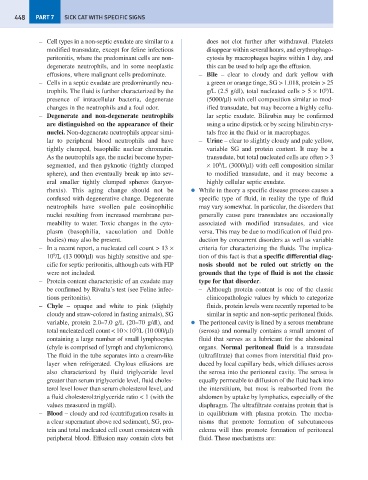Page 456 - Problem-Based Feline Medicine
P. 456
448 PART 7 SICK CAT WITH SPECIFIC SIGNS
– Cell types in a non-septic exudate are similar to a does not clot further after withdrawal. Platelets
modified transudate, except for feline infectious disappear within several hours, and erythrophago-
peritonitis, where the predominant cells are non- cytosis by macrophages begins within 1 day, and
degenerate neutrophils, and in some neoplastic this can be used to help age the effusion.
effusions, where malignant cells predominate. – Bile – clear to cloudy and dark yellow with
– Cells in a septic exudate are predominantly neu- a green or orange tinge, SG > 1.018, protein > 25
9
trophils. The fluid is further characterized by the g/L (2.5 g/dl), total nucleated cells > 5 × 10 /L
presence of intracellular bacteria, degenerate (5000/μl) with cell composition similar to mod-
changes in the neutrophils and a foul odor. ified transudate, but may become a highly cellu-
– Degenerate and non-degenerate neutrophils lar septic exudate. Bilirubin may be confirmed
are distinguished on the appearance of their using a urine dipstick or by seeing bilirubin crys-
nuclei. Non-degenerate neutrophils appear simi- tals free in the fluid or in macrophages.
lar to peripheral blood neutrophils and have – Urine – clear to slightly cloudy and pale yellow,
tightly clumped, basophilic nuclear chromatin. variable SG and protein content. It may be a
As the neutrophils age, the nuclei become hyper- transudate, but total nucleated cells are often > 3
9
segmented, and then pyknotic (tightly clumped × 10 /L (3000/μl) with cell composition similar
sphere), and then eventually break up into sev- to modified transudate, and it may become a
eral smaller tightly clumped spheres (karyor- highly cellular septic exudate.
rhexis). This aging change should not be ● While in theory a specific disease process causes a
confused with degenerative change. Degenerate specific type of fluid, in reality the type of fluid
neutrophils have swollen pale eosinophilic may vary somewhat. In particular, the disorders that
nuclei resulting from increased membrane per- generally cause pure transudates are occasionally
meability to water. Toxic changes in the cyto- associated with modified transudates, and vice
plasm (basophilia, vacuolation and Dohle versa. This may be due to modification of fluid pro-
bodies) may also be present. duction by concurrent disorders as well as variable
– In a recent report, a nucleated cell count > 13 × criteria for characterizing the fluids. The implica-
9
10 /L (13 000/μl) was highly sensitive and spe- tion of this fact is that a specific differential diag-
cific for septic peritonitis, although cats with FIP nosis should not be ruled out strictly on the
were not included. grounds that the type of fluid is not the classic
– Protein content characteristic of an exudate may type for that disorder.
be confirmed by Rivalta’s test (see Feline infec- – Although protein content is one of the classic
tious peritonitis). clinicopathologic values by which to categorize
– Chyle – opaque and white to pink (slightly fluids, protein levels were recently reported to be
cloudy and straw-colored in fasting animals), SG similar in septic and non-septic peritoneal fluids.
variable, protein 2.0–7.0 g/L (20–70 g/dl), and ● The peritoneal cavity is lined by a serous membrane
9
total nucleated cell count < 10 × 10 /L (10 000/μl) (serosa) and normally contains a small amount of
containing a large number of small lymphocytes fluid that serves as a lubricant for the abdominal
(chyle is comprised of lymph and chylomicrons). organs. Normal peritoneal fluid is a transudate
The fluid in the tube separates into a cream-like (ultrafiltrate) that comes from interstitial fluid pro-
layer when refrigerated. Chylous effusions are duced by local capillary beds, which diffuses across
also characterized by fluid triglyceride level the serosa into the peritoneal cavity. The serosa is
greater than serum triglyceride level, fluid choles- equally permeable to diffusion of the fluid back into
terol level lower than serum cholesterol level, and the interstitium, but most is reabsorbed from the
a fluid cholesterol:triglyceride ratio < 1 (with the abdomen by uptake by lymphatics, especially of the
values measured in mg/dl). diaphragm. The ultrafiltrate contains protein that is
– Blood – cloudy and red (centrifugation results in in equilibrium with plasma protein. The mecha-
a clear supernatant above red sediment), SG, pro- nisms that promote formation of subcutaneous
tein and total nucleated cell count consistent with edema will thus promote formation of peritoneal
peripheral blood. Effusion may contain clots but fluid. These mechanisms are:

